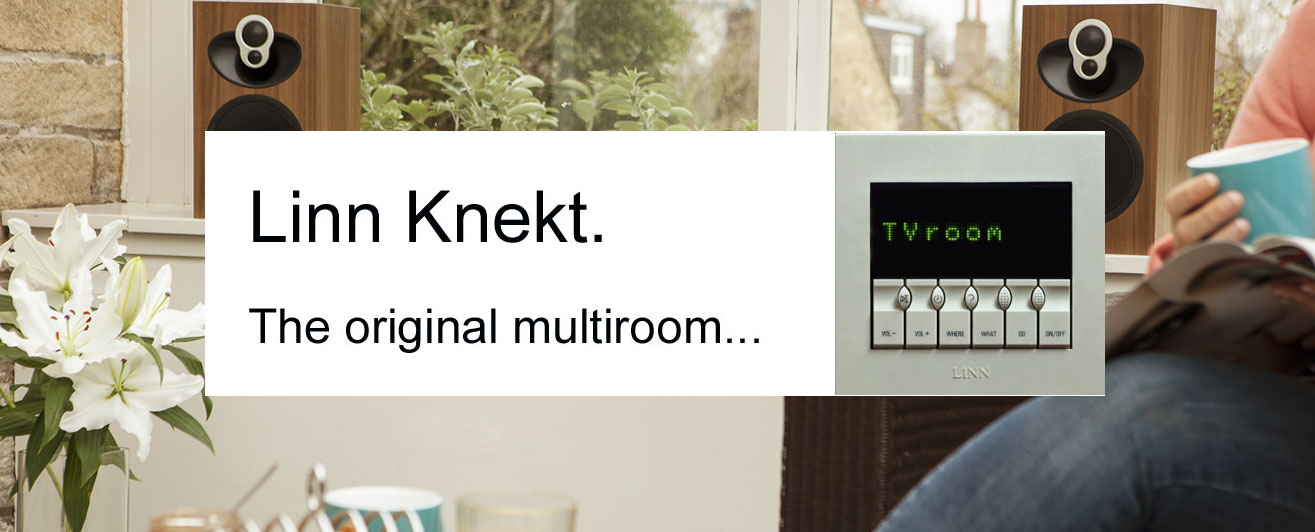Linn Knekt Integration.
The original multi room system…
In 1994, Linn introduced the Knekt multi-room system, using balanced, line-level audio distribution to achieve a new benchmark of audio quality in a distributed audio system. Linn’s system was the first to allow multi-user operation thanks to the deployment of microprocessor-enabled keypads in each room, called Knekt-RCUs (Remote Control Units) with an LED display providing instant two-way communications between the user and the equipment. And so, for the first time it was possible to choose a radio station or select a CD track on a Knekt-enabled tuner or CD player from any room of a home and to receive confirmation and status updates in real-time. Linn augmented the Knekt offering with small in-room amplifiers and in-wall loudspeakers.
Now, nearly 30 years on there are still a great many Knekt systems in use around the globe and whilst Linn has now ceased all support for Knekt we at House of Linn still receive many enquiries regarding integration of newer technologies into existing Linn Knekt systems.
If you have a functioning Linn Knekt system then it is possible to introduce Linn streaming products into the system bringing with it the benefits of tablet/phone control, external streaming services such as Tidal and Qobuz and the huge choice that is internet radio!
How Knekt worked…
An existing Linn Knekt system consists of a main system driver such as an Intersekt or possible Line driver or in a smaller system a Linn combined source and amplifier product such as a Linn Classik with a Sneaky Line driver, from these driver products cat5 cabling runs to each zone’s Knekt receiver product via Knekt-RCU room controllers for source selection, source control and volume adjustment in that room. Local amplification was provided by Linn room amps or similar along with the possibility of local source connection depending on which receiver product installed.
Back in the nineties the Knekt-RCU handled the visual display element of a Knekt system – somewhat limited by todays standards but at the time offered track details and source control information via the LED matrix scrolling display.
What can be done today?...
Most Knekt systems were installed nearly 30 years ago therefore it’s only to be expected that some elements of those systems will be beginning to fail, sadly Linn are no longer able to offer support for any Knekt related product due to the non-availability of parts and supporting software.
Some components of the Knekt system are programmed specifically for the system they are part of, and some are not. Naturally if a non-system specific component fails it can simply be replaced by another similar second-hand component but if the failed component is programmed to be system specific then simply replacing it will not work without re-programming the system, this is becoming increasingly difficult and costly and not always entirely necessary.
This is where DSM integration comes in…
All Linn Knekt sources are linked in to the system via line level RCA phono connections, therefore it is possible to connect Linn DSM via the same analog inputs.
Let’s say the Knekt system has a CD player connected which is skipping – the CD player most likely cannot be repaired, in fact why would one when the benefits of streaming are understood - the easiest solution is to connect a Linn DSM player’s analog outputs to the same Knekt input then simply by selecting that input (in this case CD) in which ever Knekt zone one is in.
Alternatively, Linn also produce two multi-zone streamers (2 streamer/4 zones and 4 streamer 8 zones) which may be able to either connect and feed to the existing Intersekt OR utilise the existing cabling depending on the original installation, generally the job is easier if all the electronics were originally installed in one location.
From this point on DSM control and material selection will be handled by the iPad/iPhone or tablet with only the zones volume adjustment remaining on the Knekt RCU.
There are a few rules…
- Current Linn DSM products do not communicate, interface or replace any Knekt products, they simply work alongside an existing and working Knekt system.
- Whilst zone volume control can also be added to the iPad, iPhone or tablet it is not advised unless the DSM is the only source to avoid alarming volume differentials between sources.
- If Knekt components are failing there is little that can be done to fix these components, it’s wiser to begin the migration over to Linn DSM. Knekt uses twisted pair cat 5 cable which can be easily re-terminated to suit the network requirements of Linn DSM allowing a complete or partial Knekt replacement if required without trashing tastefully decorated rooms!
- One DSM = one independent zone therefore the requirement of independent zones will dictate the number of DSM’s needed.
- The Knekt-RCU will not control the Linn DSM, this is done by the iPad, iPhone or tablet, all the Knekt-RCU is doing is allowing the user to select the input the DSM is connected to and adjust the volume of that source once selected. The input name will remain the same unless the Knekt-RCU is re-programmed for this new source.
Ask us…
For more information about integrating Linn DSM into Knekt multi-room systems, technical help, or if you would like to talk about upgrading please call or email Brian or Trevor.



